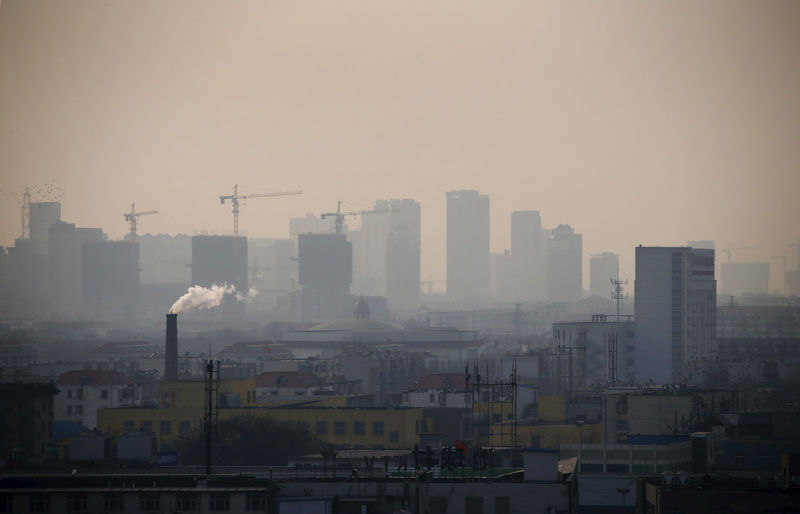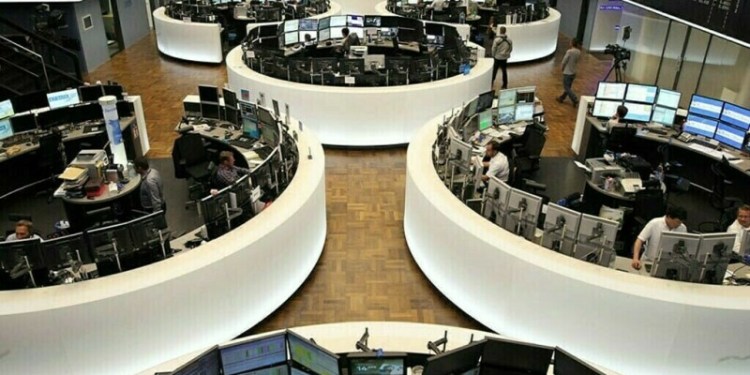 © Reuters. FILE PHOTO: File photo of smoke rising from a chimney among houses as new high-rise residential buildings are seen under construction on a hazy day in the city centre of Tangshan
© Reuters. FILE PHOTO: File photo of smoke rising from a chimney among houses as new high-rise residential buildings are seen under construction on a hazy day in the city centre of TangshanBy Naveen Thukral and Henning Gloystein
SINGAPORE (Reuters) – Industrial metals, liquefied and steel are set to finish 2017 on top of the world as a crackdown on pollution in China, the world’s no.2 economy, boosts demand for cleaner fossil fuels and raw materials vital to clean-tech industries.
For 2018, analysts predict more of the same: accelerating growth in major economies and increased infrastructure spending will drive price rises for industrial commodities and energy sources beyond the multi-year highs they’re now touching.
“I think we have seen the end of low commodity prices as funds are expected to focus on commodities in 2018, with strong economic growth,” said Terry Reilly, senior commodities analyst with Chicago-based Futures International.
Metals used in the booming renewable energy sector, including for transmission lines and solar panel wiring, have seen strong demand and price rises, as have materials like aluminum used in electric vehicles.
Copper and aluminum have risen by almost a third this year to four-year highs in the last trading week of 2017 of $7,259 and $2,270 a ton respectively.
Pan Pacific Copper, Japan’s biggest copper smelter, expects copper prices to rise more than a quarter over the next two years as global demand continues to grow and out paces supply.
Shanghai rebar futures have climbed almost 45 percent this year, to over 3,815 yuan ($585.62) per ton, driven by the closure of low-quality Chinese steelmaking plants and production curbs – to fight pollution. High construction activity also supported steel.
(GRAPHIC: http://reut.rs/2zIKsXv)
(GRAPHIC: http://tmsnrt.rs/2eCrOHk)
CHINA DRIVES GAS, OPEC CUTS OIL
Liquefied natural gas (LNG) went from loser to winner, in part for seasonal factors.
Asian spot prices for liquefied natural gas have doubled since June, to the highest level since late 2014 of over $11 per million British thermal units.
Until the last quarter of the year, LNG had been one of 2017’s worst performing commodities.
The late rally has been driven by a huge gasification program in China which this year alone moved millions of households and industry from coal to gas for heating, just as a cold winter bites.
China’s gasification is aimed squarely at reducing coal use amid a determined effort to roll back pollution that has plagued cities for years.
“We have seen some serious crackdown on pollution in China, that will boost demand for metals and gas,” Reilly said.
As part of this policy, China is making huge investments into renewable power generation.
World solar power capacity has ballooned to around 300 gigawatts (GW) from just 1 GW in 2000, according to International Renewable Energy Agency (Irena) data, a number set to double by 2020.
Growth is largely driven by China, approaching 100 GW of capacity. Irena says China alone can add 50 GW a year of capacity.
Despite China’s renewable drive, even coal prices did relatively well in 2017. Even this is related to China’s pollution crackdown.
Australian coal prices were up 10 percent to over $100 a ton, as China ordered the closure of several domestic mines, forcing utilities to import more.
In the world’s most traded commodity, oil, broke through $67 per barrel for the first time since mid-2015 in the last week of 2017, up 17 percent for the year but 50 percent above mid-2017, amid record trading volumes.
Oil has been lifted by efforts led by the Organization of the Petroleum Exporting Countries (OPEC) and Russia to withhold production in order to prop up prices.
Preventing further price rises has been U.S. oil production, which has soared more than 16 percent since mid-2016 and is approaching 10 million barrels per day. Only OPEC king-pin Saudi Arabia and Russia produce more.
RECORD CROP YIELDS, LOW PRICES
Contrary to energy and industrial commodities, most agricultural products will finish 2017 with lower prices, squeezed by record output.
Raw sugar has lost almost a quarter of its value, with the International Sugar Organization forecasting a global sugar surplus of 5 million tonnes in 2017/18 compared with a deficit of 3.1 million in 2016/17.
Meanwhile coffee is down 20 percent as favorable weather has boosted Vietnam’s production.
World corn production has hit a record high for eight out of the past 10 years. Soybean production has climbed to all-time highs in four out of the last five years, according to the U.S. Department of Agriculture. This led to a 5 percent decline in prices.
Wheat is on track for a modest 5 percent gain in 2017, after losing ground for the past four years, as world supplies of high-protein wheat tighten due to crop losses in the United States and Australia, in part related to La Niña weather occurrence.
Malaysian palm oil dropped 10 percent in 2017 with production in Southeast Asia outpacing demand from top importers China and Europe.
Elsewhere, Tokyo rubber has fallen 18 percent in 2017 after being one of the best performing commodities in 2016.
Source: Investing.com




























